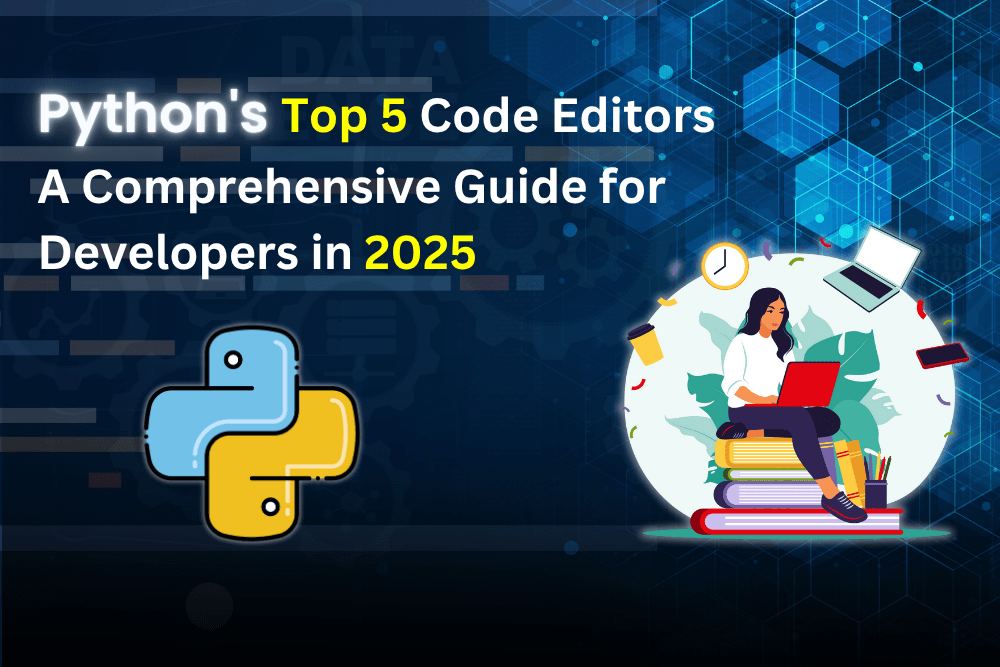Python has grown from a modest scripting language into a global phenomenon in programming. From powering AI models to running backend servers and facilitating data analysis, Python is almost everywhere today. With tech giants like Google, Facebook, NASA, and Netflix using it, Python’s widespread adoption is a testament to its capabilities.
But why is Python the greatest choice for software engineers, data scientists, and developers alike? In this detailed article, we’ll explore the main benefits of Python and why it’s considered the top choice in 2025 and beyond.
Upgrade Your Skills – Learn Python for Data Science, Automation, and Development.
1. Simplicity and Readability
One of Python’s core philosophies is simplicity. Its syntax is clean and mirrors natural language, which makes it exceptionally easy to read and write.
Example:
python
Copy
Edit
for name in names:
print(f”Hello, {name}”)
Compared to many other languages, Python eliminates unnecessary symbols and punctuation, focusing instead on indentation to define code blocks. This makes it a very effective tool for experts and a perfect first language for beginners.
Benefits:
- Faster learning curve.
- Easier debugging and maintenance.
- Improved collaboration among teams.
2. Versatility Across Domains
Python is not confined to a single application area. It supports:
- Web development (e.g., Django, Flask)
- Data science (e.g., Pandas, NumPy)
- Artificial Intelligence and Machine Learning (e.g., TensorFlow, scikit-learn)
- Scripting and automation
- Game development (e.g., Pygame)
- Cybersecurity and penetration testing
Few languages can rival this level of cross-domain utility. Whether you’re building a web API or training an AI model, Python has the ecosystem and tools to support you.
3. Rich Ecosystem and Libraries
Python’s strong ecosystem is what really makes it powerful. Developers can save hundreds of hours of coding labor by using the vast array of libraries and frameworks made accessible via the Python Package Index (PyPI).
Key Libraries:
- NumPy & Pandas – for numerical computations and data manipulation.
- Matplotlib & Seaborn – for data visualization.
- Django & Flask – for full-stack web development.
- TensorFlow, PyTorch – for deep learning.
- BeautifulSoup & Scrapy – for web scraping.
- OpenCV – for computer vision.
- Whatever your need, chances are there’s already a Python library that solves it.
Master Python from the basics to advanced concepts with our Python courses in Pune
4. Large and Supportive Community
One of Python’s greatest advantages is its community. Tools, frameworks, and educational materials are improved by millions of developers worldwide. This community ensures:
- A constant stream of tutorials, courses, and documentation.
- Rapid bug fixes and updates in libraries.
- Active Q&A forums like Stack Overflow and Reddit.
For beginners, this is invaluable. Stuck on a problem? There’s likely someone who has already solved it.
5. Cross-Platform Compatibility
Python is compatible with Windows, macOS, and Linux, among other operating systems. This cross-platform functionality is particularly
- Advantageous for developers that operate in a variety of settings.
- Companies are deploying software to a wide range of user systems.
- Cloud-native applications that need OS-agnostic solutions.
Write once, run anywhere—Python makes it easy to create and distribute applications across different platforms without significant code changes.
6. Ideal for Prototyping and Rapid Development
Startups and enterprise teams often need to quickly prototype and validate ideas. Python’s concise syntax, dynamic typing, and huge library base make it ideal for rapid prototyping.
Instead of weeks, you may get from concept to MVP (Minimum Viable Product) in a matter of days.
Use Case:
An AI startup might build a working image recognition system in Python within days using TensorFlow and OpenCV—something that would take much longer in C++ or Java.
7. Integration Capabilities
Python works nicely with various technologies and languages. It can:
- Embed C/C++ code for performance.
- Interact with Java using Jython.
- Use IronPython to interact with.NET components.
- Use libraries such as SQLAlchemy and SQLite to connect to databases.
- Interface with APIs using requests, httpx, or aiohttp.
This makes it easy to embed Python into existing systems or extend its functionality with modules from other languages.
8. Strong in Automation and Scripting
Python shines in automation. Whether it’s renaming files, scraping websites, automating data entry, or managing servers, Python makes scripting straightforward.
Example:
python
Copy
Edit
import os
for filename in os.listdir():
if filename.endswith(‘.txt’):
os.rename(filename, f”archived_{filename}”)
This makes Python the go-to choice for DevOps engineers, system admins, and anyone involved in repetitive tasks.
9. Powerhouse for Data Science and AI
Python is often the default language in data science, machine learning, and artificial intelligence due to:
- Readability, which makes mathematical logic easier to implement.
- Libraries like NumPy, Pandas, scikit-learn, TensorFlow, PyTorch.
- Tools like Jupyter Notebooks for interactive exploration.
- Integration with visualization tools (Matplotlib, Plotly).
- With the rise of big data and AI, Python’s relevance continues to soar in these domains.
10. Academic and Industry Support
Python is taught in most universities and coding bootcamps because of its clarity and power. This educational dominance ensures that:
- New programmers learn Python first.
- Research communities publish code in Python, especially in AI and science.
- Tech companies standardize Python in their development stacks.
- This academic-industry feedback loop reinforces Python’s dominance.
Top Reasons to Learn Python: Why This Language Dominates in 2025
Learning the correct programming language may significantly impact your technical skills and career in the ever changing field of technology. Python stands out among the many options as one of the most popular and influential programming languages available today.
Python’s popularity has surged consistently over the past decade. Whether you’re an aspiring developer, data analyst, or automation enthusiast, Python offers the tools, simplicity, and power you need to succeed. The main arguments for why studying Python is a wise choice in 2025 and beyond are examined in this essay.
1. Beginner-Friendly Syntax and Readability
One of Python’s most praised features is its clean, readable, and intuitive syntax. It was designed to be easy to understand and write, which makes it ideal for beginners who are learning how to program for the first time.
Why It Matters:
- Minimal punctuation and natural language structure.
- Uses indentation rather than complex curly braces.
- Easier debugging and fewer syntax errors.
Example:
python
Copy
Edit
if age > 18:
print(“You are an adult”)
This simplicity reduces the learning curve and lets beginners focus on learning programming concepts rather than dealing with complex language rules.
2. Wide Range of Applications
Python is incredibly versatile. It’s not limited to just one area of software development. You can use it for:
- Web development (Django, Flask)
- Data science and data analysis (Pandas, NumPy)
- Artificial Intelligence and Machine Learning (TensorFlow, PyTorch)
- Scripting and automation
- Game development (Pygame)
- Desktop application development
- Cybersecurity and ethical hacking
Why It Matters:
Learning Python opens the door to multiple career paths. Whether you want to become a data scientist or a full-stack web developer, Python has the tools and community support to help you.
3. Massive Community and Support
One of the biggest and busiest programming communities in the world is found in Python. This means you’ll never be stuck for long, no matter your skill level.
Key Benefits:
- Countless tutorials, documentation, and forums.
- Thousands of open-source projects to contribute to.
- Quick answers to coding questions on Stack Overflow and GitHub.
This level of support is especially useful for self-taught programmers and professionals who rely on community-driven solutions to improve their skills and productivity.
4. Rich Library and Framework Ecosystem
Python’s extensive library ecosystem is another standout advantage. Python makes it simpler to create complicated applications without having to start from scratch because to the more than 300,000 packages that are accessible on the Python Package Index (PyPI).
Popular Libraries and Frameworks:
- Data Science: Pandas, NumPy, SciPy
- Machine Learning: scikit-learn, TensorFlow, PyTorch
- Web Development: Flask, Django, FastAPI
- Automation: Selenium, BeautifulSoup
- Visualization: Matplotlib, Seaborn, Plotly
- These packages help you build real-world applications efficiently and effectively.
5. Strong Demand in the Employment Market
One of the most in-demand abilities in the worldwide labor market is Python. Companies across industries are actively hiring Python developers, data scientists, and AI engineers.
Career Opportunities:
- Software Developer
- Data Analyst
- Machine Learning Engineer
- DevOps Engineer
- QA Automation Tester
- Cybersecurity Analyst
Salary Insights (2025 Estimates):
- Entry-level: $70,000 – $90,000/year
- Mid-level: $100,000 – $130,000/year
- Senior-level: $140,000+/year
Whether you’re freelancing, joining a startup, or aiming for a role at a tech giant, Python Expertise pays well and offers strong job security.
6. Excellent for Machine Learning and Data Science
The unchallenged leader in data science and artificial intelligence development is Python. The language’s simplicity and powerful libraries make it ideal for handling large data sets, training ML models, and visualizing results.
Why Python for AI:
- Rapid prototyping and deployment.
- Strong integration with AI libraries (TensorFlow, Keras).
- Extensive visualization tools.
- Community-driven innovation in the AI field.
If you’re interested in working with data, predicting outcomes, or building smart systems, learning Python is a must.
Conclusion
Python’s rise to dominance isn’t accidental—it’s the result of thoughtful design, community support, and unmatched versatility. Whether you’re a beginner or an industry veteran, Python offers tools, frameworks, and possibilities that empower you to build virtually anything.
Its key benefits—simplicity, broad applicability, strong community, and a vast library ecosystem—make it the best option for most programming needs in 2025 and beyond.
Python is the obvious choice if you’re unsure about which programming language to study or devote more effort to. It’s not just a language—it’s a gateway to innovation, creativity, and a successful tech career.





